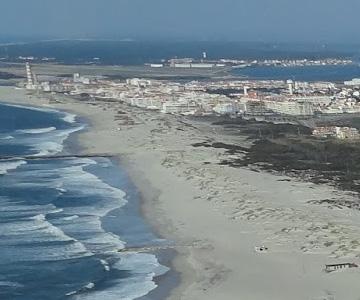On 9 November 2013, the headline of the Portuguese Expresso newspaper read, “The sea could swallow almost 100 meters of the Coast of Aveiro”. The article referred to the results of a research project by Aveiro University (AdaptaRia), which modelled the effects of coastal erosion and rising sea levels on the coast South of Aveiro in northern Portugal. These concerns were not new. As early Local newspapers were reporting on the growing problem of coastal erosion and rising sea level in the region as early as 2010.
The real storm, however, came in January 2014. Impressive footage on Portuguese television showed extensive damage inflicted upon the coast, with sand dunes and beach bars were destroyed, a threat to the livelihoods of local residents.
A local resident, named Sérgio, surfs the local beaches and is very concerned with the problem of coastal erosion. He says, “I’m not an expert, but the sea currents have been changing, I fear what the future will bring if we do nothing…” Another local resident, an engineer who works for the Port of Aveiro has claimed, “We have to do something, we will put sand or something else, but there is no way we will have that long beach back…those are past waters…”

Damage to the coast from storm events (Photo credit: FFCUL)
The coastal area between Barra and Areão Beach is currently considered one of the most vulnerable stretches to storm surge in Europe. According to recent studies (CHANGE), sea level may rise up to a meter in 2100 and an increase is expected in extreme events. This is particularly true for storm surges, which are already frequent in the region during the winter months. Indirect impacts include aggravated coastal erosion and loss of beach sand; recurrent flooding; loss of revenues in tourism and water sports; destruction of urban infrastructures, and devaluation or destruction of residential areas.
Scientific research has identified possible adaptation strategies for the area, such as sand dredging and delivery, and structural protection works. But how is action actually taken? Two municipalities and a considerable body of institutions and local associations are key actors for adaptation in the region, but they have not yet agreed on an action-plan. This is where the BASE project comes in.
Acting as facilitators, BASE research in the area has been leading the process of identifying and discussing potential adaptation measures for this coast, in order to promote the design of an action plan for local adaptation to climate change and the impacts of a rising sea level in the area. Stakeholder events are at the heart of BASE research in the southern coast of the Aveiro District, and those engaged include local administrators, business owners, fishermen and residents.
Clinging on to ‘past waters’ seems to be the biggest challenge for consensus around planning adaptation. Local mayors have been participating in BASE action-research approach to support a local plan on what measures could be implemented, asking for updated knowledge on adequate costs and benefits. Yet, they too are clinging to the notion that the coast line should be kept at all costs. Is that be a realistic option? Researchers and local engineers seem to disagree, yet the hope of binding local actors in a concerted plan for actions leaves much room for profound changes in the future of the region.
As is stated by Sérgio, “We have to act together, I think, we have to lobby together and find ways of financing and protecting our coast. So far we haven’t done that. You know, I think there is not real knowledge…we need more. I look and look and I can’t find any good studies, that’s what I hope we have now, better studies, better information and more action.”
By: Ines Campos, FFCUL




